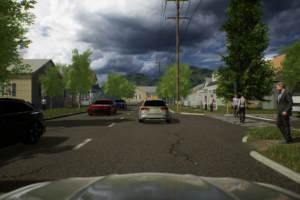Virtual Environments for Simulation Testing
Autonomous vehicles need validating in the real world. A large part of deploying and testing before this stage is in simulation. The environment the autonomous systems are tested in can play an important role in the success or failure of a validation process. Furthermore, the virtual environments used for simulation are also used for synthetic data generation, used to train perception systems.
Synthetic Data and Virtual Environments
How can an autonomous vehicle train a perception system using synthetic data?
An autonomous vehicle can train a perception system using synthetic data by creating virtual environments that mimic real-world scenarios and feeding them to the perception system as input. The system can then learn to recognize and respond to various objects, such as other vehicles, pedestrians, and traffic signals, by processing the synthetic data. This approach can be useful for testing and training the system in situations that may be difficult or dangerous to replicate in the real world. Additionally, synthetic data can be used to generate a diverse set of scenarios and edge cases that can help improve the robustness of the perception system.
And how can you create these virtual environments?
There are several ways to create virtual environments for training autonomous vehicles’ perception systems. One approach is to use computer-generated imagery (CGI) to create 3D models of the environment, including objects such as buildings, roads, and other vehicles. These models can then be used to simulate different scenarios, such as different lighting conditions, weather, and traffic patterns.
Another approach is to use real-world data, such as photographs and videos, to create photorealistic virtual environments. This can be done by using techniques such as photogrammetry, which allows you to create 3D models from 2D images, and then use this data to create a virtual environment.
Additionally, there are some tools and simulators that can be used to create virtual environments such as CARLA, Airsim, and Unity. These simulators are designed for autonomous vehicle research and can be configured to simulate a wide range of scenarios and environments.
How long does it take to create a virtual environment?
The time it takes to create a virtual environment for training an autonomous vehicle’s perception system can vary widely depending on the complexity of the environment and the methods used to create it.
If the virtual environment is simple and only contains a few basic elements, it could be created relatively quickly, in a matter of hours or days. For example, a virtual environment that simulates a simple road with a few buildings and vehicles could be created in a short amount of time.
However, if the virtual environment is more complex and includes a greater variety of objects, it may take longer to create. For example, a virtual environment that simulates a city with a large number of buildings, roads, and vehicles, could take weeks or even months to create. Additionally, if the virtual environment is created using real-world data, such as photographs and videos, the process of creating the virtual environment could be slowed down by the time required to collect and process the data.
Furthermore, the time required to create a virtual environment also depends on the tools and methodologies used. For instance, using a pre-built simulator such as CARLA, Airsim or Unity can speed up the process as they come with pre-built assets and functionalities for creating and simulating environments.
Overall, creating a virtual environment for training an autonomous vehicle’s perception system can be a time-consuming process, but it can be an important step in ensuring that the system is able to perform well in real-world scenarios.
How many different virtual environments are needed to validate an autonomous stack?
The number of virtual environments needed to validate an autonomous stack can vary depending on the complexity of the stack and the specific scenarios it is intended to operate in. In general, it is important to create a diverse set of virtual environments that cover a wide range of scenarios and conditions to ensure that the autonomous stack is able to perform well in a variety of situations.
A good practice is to create virtual environments that represent different types of roads and environments, such as highways, residential areas, and rural roads. The virtual environments should also include different weather conditions, lighting conditions, and traffic patterns, as these can all have an impact on the performance of the autonomous stack.
Additionally, it’s important to consider the edge cases and the corner cases that the autonomous stack will have to handle, such as adverse weather, low visibility, and unexpected or rare events. For example, creating virtual environments that simulate a construction zone or a road closure can help ensure that the autonomous stack can handle these types of scenarios.
It’s important to note that the more diverse and realistic the virtual environments are, the more reliable the validation of the autonomous stack will be. However, the number of virtual environments needed can be high, as creating a virtual environment can be a time-consuming process. Therefore, it’s a balance between the number of virtual environments and the resources available.
In summary, the number of virtual environments needed to validate an autonomous stack will depend on the complexity of the stack and the specific scenarios it is intended to operate in, but generally, the more diverse and realistic the virtual environments are, the better the validation of the autonomous stack will be.
And what about if the domain is not on-road, but off-road? Can you validate an autonomous stack for off-road vehicles using virtual environments?
It is possible to validate an autonomous stack for off-road vehicles using virtual environments, although it may be more challenging than validating an on-road autonomous stack. Off-road environments can be more difficult to simulate due to the greater variety of terrain types, obstacles, and conditions that may be encountered.
To create virtual environments for off-road vehicles, it is important to consider the specific types of terrain that the vehicle will be operating in, such as sand, mud, gravel, and rock. The virtual environments should also include obstacles such as trees, boulders, and ditches that the vehicle may encounter. Additionally, it is important to simulate different weather conditions, such as rain, snow, and fog, as these can have a significant impact on the vehicle’s performance.
It is also important to simulate different types of off-road scenarios, such as steep inclines, descents, and uneven terrain. These scenarios can be challenging for an autonomous vehicle, and it is important to ensure that the autonomous stack can handle them safely.
Additionally, it is important to consider the edge cases and the corner cases that the autonomous stack will have to handle, such as adverse weather, low visibility, and unexpected or rare events. For example, simulating an off-road vehicle stuck in a deep mud or navigating a narrow path between rocks can help ensure that the autonomous stack can handle these types of scenarios.
In summary, it is possible to validate an autonomous stack for off-road vehicles using virtual environments. However, creating virtual environments that accurately represent off-road environments can be more challenging and requires a more detailed consideration of different types of terrain, obstacles, and conditions that the vehicle may encounter. Additionally, simulating different scenarios and edge cases is crucial to ensure that the autonomous stack can handle them safely.
How much time can you save by testing and validating autonomous vehicles in virtual environments before deploying in the real world?
Testing and validating autonomous vehicles in virtual environments before deploying them in the real world can save a significant amount of time and resources. By simulating a wide range of scenarios and conditions in a virtual environment, it is possible to identify and address issues with the autonomous stack before deploying it in the real world. This can reduce the time and resources required for testing and validation in the real world, as well as reducing the risk of accidents or other incidents caused by a malfunctioning autonomous vehicle.
In virtual environments, autonomous vehicles can be tested and validated in a controlled and repeatable way, which allows for faster and more efficient testing. For example, in a virtual environment, it is possible to quickly change the weather conditions, traffic patterns, or other variables to see how the autonomous stack performs under different conditions. Additionally, virtual environments allow for the testing of edge cases and scenarios that would be difficult or impossible to replicate in the real world, such as a construction zone or a road closure.
Furthermore, with virtual environments, it is possible to run multiple simulations simultaneously, which can speed up the testing process. This can be particularly useful for testing different variations of the autonomous stack, or for testing different components of the stack separately.
Driver-assist Autonomous Features
Repli5 offers highly realistic 3D simulation environments to train and test autonomous solutions in many off-road and on-road domains.

Enabling the future of Perception
© Repli5 AB. All rights reserved.